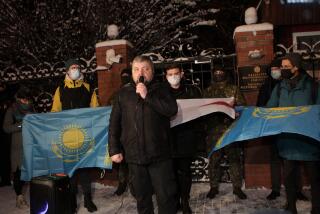Ah, Solidarity
- Share via
Gdansk, Poland — EXACTLY A quarter of a century ago, here in Gdansk, the first velvet revolution began. When, on a boiling summer’s day in August 1980, I arrived at the blue-gray gate of the Lenin Shipyard, festooned with flowers and photographs of the Polish pope, with loudspeakers blaring patriotic hymns and farmers bringing baskets of food; when my colleagues and I were greeted at the gate by a young worker, naked to the waist but carefully identified as a picket by a red-and-white armband, and he led us into the shipyard through two lines of strikers in dusty blue overalls, cheering as if we had personally brought the solidarity of the world; then already I knew that something new and unique was happening here -- a workers’ revolution against a so-called workers’ state!
Yet even as this solidarity strike mushroomed into Solidarity, a 10-million-strong mass movement of national and civic liberation, we could not imagine the consequences. It’s not just that 25 years later Poland is a free country playing a significant role in the European Union and NATO -- albeit a country with a weak state and an alarmingly high level of unemployment, corruption and popular dissatisfaction. With hindsight, we can see that this Polish revolution was the beginning of the end of communism in Europe, of the Cold War, and thus of the unnatural East-West division of our continent symbolized by the Berlin Wall. And not just of our continent, for that Cold War divided the world. In this sense, we might even say that what came to be called “the Polish August” was the beginning of the end of the short 20th century.
Of course we knew none of that at the time. We didn’t even know what would happen today, let alone tomorrow. Would Poland’s communist rulers send in their troops, just as they had done to crush a workers’ protest in this very place less than 10 years before? Or would Leonid Brezhnev summon his tanks, as he had to trample the Prague Spring in Czechoslovakia in 1968?
Now I stand again in front of those shipyard gates, still decorated with flowers and a photograph of the Polish pope, but looking strangely artificial, like the museum piece they have become. As Lech Walesa and his foreign guests, including Vaclav Havel, the hero of Prague’s velvet revolution in 1989, join in celebrations of the anniversary, I reflect on the sheer impossibility of conveying to a 15-year-old today what it felt like to be there. The smells and sounds, the fear, the hope, the excitement and the sheer exhaustion.
Suddenly, I realize that we are today at exactly the same distance of time from these events as I was from the end of World War II when I was 15. And I recall how I listened then to my father’s stories of the liberation of the western half of Europe. (He landed with one of the first waves on D-day.) Full of respect, greatly impressed, but not really feeling what it was like to be there. Why is the emotion impossible to convey? At bottom, it seems to me, for the simple reason that we do now know how it turned out in the end. So much of the tension, the pressure, the excitement came from the fact that we did not know what would happen from one hour to the next. A revolution whose subsequent course is known is like a pressure-cooker with all the steam let out.
Instead, let’s address the future. Not of Poland particularly, nor of the medium-size trade union that Solidarity is today, but of the new model of peaceful revolution that Solidarity pioneered. For what the shipyard workers began in 1980 was a fundamental redefinition of what we mean by revolution, supplanting the old model of violent overthrow that had prevailed for nearly two centuries since the French Revolution began in 1789. We might call it the Jacobin-Bolshevik model: storming the Bastille or the Winter Palace, executing the king or the czar, a festival of popular liberation turning to terror as the revolution devours its children. I remember vividly how Solidarity and its advisors drew lessons from this history, and from the more recent experience of failed uprisings against Soviet rule. The Polish dissident Adam Michnik explained: We have learned from history that those who start by storming the Bastille will end up building their own Bastilles.
Instead, they tried a new model: peaceful, self-limiting, evolutionary, negotiated revolution. No one yet called it a velvet revolution -- that had to wait until Prague in 1989 -- but that is what it was: the first velvet revolution. It seemed to have failed, when martial law was imposed in late 1981. But Solidarity never entirely died. When the great thaw came with Mikhail Gorbachev, it was there to complete the job in 1989.
Other velvet revolutions have followed, from Prague and Berlin in 1989 to Serbia, Georgia and the Orange Revolution in Ukraine last year, but also on other continents -- in the Philippines and in South Africa. Each country has done things its own way, with new and distinctive features. It would be absurd to suggest they were all following the Polish example -- and the Poles themselves learned something from the Spanish and Portuguese. The point is that this has become almost the world’s default model of revolution.
Like the original Jacobin-Bolshevik version, it’s a model made in Europe. These days the Bush administration is rather aggressively pushing the idea of spreading velvet revolutions- -- not just to the last remaining European dictatorship, Belarus, but also to countries in the wider Middle East. How should Europeans react? The last thing we should do, I think, is to leave talking of freedom entirely to Americans.
Instead, as European Commission President Jose Manuel Barroso did eloquently in Poland this week, we should say plainly that the causes of Europe and freedom march together. Barroso, who himself remembers the fall of the dictatorship in Portugal in 1974, talks of this as the European part of “a worldwide movement to freedom.” And from Portugal in 1974 to Ukraine now, the hope of rejoining Europe has helped inspire such revolutions, while the process of preparing for membership in the EU has helped stabilize and secure fragile democracies in transition.
In short, we have our specifically European version of regime change. We should be proud of it, and we should promote it vigorously. But just as the velvet revolutionaries since 1980 have been distinguished by a concern for the means adopted to achieve the end, so should the democracies of the European Union be clearer about the means that are legitimate -- and those that are not legitimate -- to promote democracy among our neighbors. To develop some international norms for the external encouragement of velvet revolutions would be a fine way to mark this extraordinary anniversary of the first of them.
TIMOTHY GARTON ASH is professor of European studies at Oxford University and a Hoover Institution senior fellow.
More to Read
Sign up for Essential California
The most important California stories and recommendations in your inbox every morning.
You may occasionally receive promotional content from the Los Angeles Times.










